This page highlights SF that’s already been (partially or fully) translated into English and is looking for a US/UK publisher. Great stuff here!
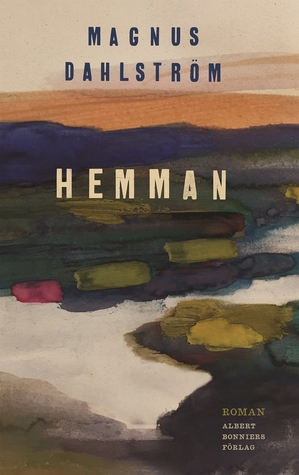
Homestead (2018)
by Magnus Dahlström
translated from the Swedish by Neil Smith
publisher: Albert Bonniers förlag
length: 407 pages
rights: Madelene Andersson, Bonnier Rights- Madelene.Andersson@bonnierrights.se
“Writer Magnus Dahlström has achieved success as a novelist and dramatist. His latest book is a carefully crafted tale of horror and suspense and has been received with much acclaim in Sweden. The characters form a large cast of people in a rural community and the narrative switches from one to another. At the centre is Majvor, to whom we are introduced at the beginning.” Swedish Book Review

Moon Theater (2015)
by Ieva Melgalve
translated from the Latvian by Suzanne McQuade
publisher: Rīga, Zvaigzne ABC
length: 320 pages
foreign rights: All languages available
contacts: Mrs. Bārbala Simsone, barbala.simsone@zvaigzne.lv www.zvaigzne.lv
Sample_translation_MoonTheater.pdf
“In an enormous theatre on many stages there are theatre performances all happening at the same time. The actors don’t have their own identity outside of their stage lives, and no other objective than just to get the chance for a better part and try to not get on the playrights’ blacklists. Who are these playwrights, who is the audience, and do they really exist? No one knows (although a few of them – the inquisitive young Lapsa, for example – tries to find out). One of the book’s central roles – an Actor who doesn’t have his own name – desperately tries to take part in the scenarios presented to him, but each time he tries to play his role honestly, it becomes more and more bizarre, tearing down the border between performance and truth. Similarly, the Mime – one of the androids equipped with artificial intelligence who maintains order in the theatre world – tries to play the role of guardian for the actors. However, as the Mime gradually awakens to a consciousness that becomes his own, he can no longer react to what is happening in the theatre without emotion. Perhaps they could continue to play their parts if the planned performances weren’t shaken by a resistance movement trying to realise the Actor’s identity behind the scenes and possibly even do away with the theatre’s power altogether. Yet their road isn’t easy – the idealistic Malda, who’s expecting a child, can no longer separate true love from performed love, and the tricky Gurds, sensing imminent danger to the movement, tries to make a scapegoat out of the egotistical Vladi, who in turn has landed himself a good part, no longer wanting to resist the existing order…”- from Latvian Literature
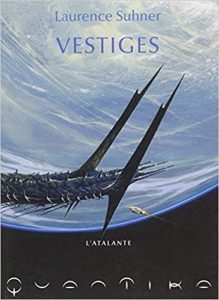
Vestiges (Vol 1 of the QuanTika trilogy) (2012)
by Laurence Suhner
translated from the French by Sheryl Curtis
publisher: L’Atalante
length: 576 pages
“The plot of QuanTika takes place 300 years in the future on a frozen but inhabitable extrasolar planet of the AltaMira binary system: Gemma, a snow-ball Earth, as the astronomers call it.
Ambre Pasquier, a young exobiologist, who has always been attracted by this distant world, finally decides to travel to the colony. She is convinced that her past, which she has forgotten after a trauma at the age of thirteen, is linked to Gemma and, especially, to the strange artefact, the Great Arch, in orbit around the planet and to the ruins that are supposed to be hidden under the ice shield. Soon after she settles there Ambre starts to be haunted by dreams that put her in contact with the traces of the first visitors to Gemma, the Builders.
She organizes a scientific expedition—the Archea mission, whose official aim is to look for primitive forms of life in the ice. In fact, she has a completely different objective—keeping it secret to avoid interference by the militia, a pseudo-military organisation having recently taken control of the colony. A passage has to be cut through the ice by means of a giant tunnelling machine to get to the rock substrata and ruins that Ambre is certain to discover there. Around twenty scientists have been recruited: Glaciologists, geophysicists, exobiologists, geneticists, climatologists, engineers, doctors. Two people have infiltrated the team. One works on behalf of a group of physicists who for over ten years have been studying the particularities of a specific planetary zone affected by fluctuations of the space-time. The other works for the militia which has recently taken control of the colony.
The expedition turns to chaos as scientists of the expedition discover an ancient Entity trapped in a prison built by the Builders, the first visitors of Gemma. They called it the Devourer of Reality. This is also the origin of the mysterious variations of space-time in this area.
The trilogy speaks about science and myths; the way humans understand the universe, compared to a totally different civilization whose technology has been built on intuition and instinct, a civilization based essentially on mythical and poetic thought, a civilization in which science seems useless and for which the notions of mathematics and distance are pure aberrations, yet a technological civilization. A paradox that will lead Ambre back to the mystery of her origins and far beyond human nature, to the land of the Builders: Timhkâ, an ocean planet.”- Strange Horizons
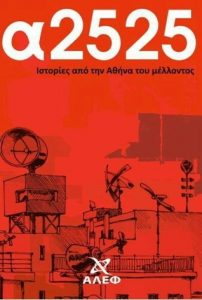
α2525: Stories from Future Athens (2018)
Email: gkatsav@otenet.gr
Publisher: ALEF (Athens Science Fiction Club) (in Greek)
Translation in English by Dimitra Nikolaidou & Vaya Pseftaki
Illustrations: Giannis Savvidis
Length: approximately 35,500 words (180 pages, illustrations included)
Keywords: Future Cities, Climate change, Augmented Reality, Virtual Reality, Genetic Engineering, Civil Unrest, Migrants, Collectivity, Global Development, Epidemics
Art Exhibitions: The project “a2525: Stories from future Athens” by Lina Theodorou, including the book printed in Greek, has been or will be exhibited in Athens, Berlin and Paris.
Central Theme: An anthology, consisting of thirteen short stories centered on the future of Athens in various time periods. Eleven Science Fiction authors have contributed stories based on an art project by Lina Theodorou for the exhibition Tomorrows, depicting Athens in Science Fiction.
Although the anthology was created to be exhibited as part of the art project, it is an entirely independent work on its own.
Themes and Plots:
Roseweed – Vasso Christou
Climate change has flooded the coastal cities. When Alba, a civil engineer who takes samples from the foundations of sunken building of Piraeus, finds out that her boss systematically downgrades the certificates of building habitability, she conducts a search that brings her face to face with a new, extreme form of entertainment.
Fish Have No heart – Titika Bourba
Fish-shaped AIs are working to remove plastic from the Mediterranean. In due course, these artificial fish become autonomous and attack everything that does not belong in the underwater environment, humans included.
Social Engineering – Kostas Charitos
Athens is divided in augmented reality zones, controlled by guilds and organisations, while the real city is full of abandoned ruins. When Daniel, a social engineer, is recruited by a customer corporation to win a referendum for the installation of augmented reality in the unclaimed areas of the city, he finds a way to liberate the citizens from the false images once and for all.
The Human(c)ity of Athens – Ioanna Bourazopoulou
The whole world is united and the working people are forced to move eternally from place to place, with no regard to family ties. Station manager Madebo has merely hours to adjust to his new post in Athens before offering a welcome to newly arriving workers.
The Bee Problem – Yannis Papadopoulos & Stamatis Stamatopoulos
The bees have become extinct. Nikitas, a former cop who is hidden in an anarchist collective, makes his living by repairing the microscopic drones which are used for the pollination, until the appearance of a few real bees will cause the disturbance that will force him to make some hard decisions.
Dutch Clay – Titika Bourba
When the rising seas find everybody in the world unprepared, the Dutch, who have obtained the technology of building dams and stabilizing the ground, make coercive deals with the southern European countries, reshaping the map of the world.
Bagdad Square – Michalis Manolios
When two lovers, who meet exclusively inside a virtual reality package, never make it to their real life date, they discover that they both live in very similar yet parallel versions of Athens, and perhaps both their worlds are simulations in a virtual reality too.
T2 – Kelly Theodorakopoulou
While a young well-to-do couple goes from Piraeus to their doctor in Kifissia, we learn that in Athens people may choose between the expensive but clean electric train T1, or the cheaper, dirty T2. During their visit to their doctor, the young couple is devastated to find out that their expected child will have brown eyes, a sign of social inferiority.
The battle of Votanikos – Dimitris Fyssas
A Reuter’s journalist describes and comments on the battle fought in and around the mosque of Votanikos, caused by the abduction of the mayor and several members of the city council of Athens by jihadists.
GodGates – Titika Bourba
The Greek Orthodox Church is funding several programs to proselytize alien beings should the case arise, and to collect data from extraterrestrial signals. The faithful are called to use their computers and mobile phones for the crowd processing of those signals.
Alekos Toullios – Teti Theodorou
A typhoid epidemic spreads mysteriously in the ruined neighbourhoods of Athens. Alekos Toullios is a blogger who manages to direct his group to post truthful information about the conditions in the area of the centre, but nobody has a clue about his ability to filter information correctly.
Abacos – Titika Bourba
The Abacos technology spreads extremely fast in the Mediterranean area, offering a virtual gastronomic experience, which is as good as the real one and presumably safer for the person’s health. It is, of course, expensive.
Needle in the Eye – Hephaestion Christopoulos
A deadly epidemic spreads through the world, and death in a public place becomes a taboo. Those who feel their end approaching retreat to the necropolises growing all over the Earth. When the narrator’s brother dies in public view, he assumes the shameful task of transporting him to the necropolis of Drapetsona. A woman, victim of the plague herself, helps him all the way in.
Publishing Project: For each short story in “α2525” there is an original art piece, by Giannis Savvidis, inspired by the idea, the descriptions or the content of this story. The anthology is published in Greek by ALEF (Athinaiki Leshi Epistimonikis Fantasias), the Science Fiction Club of Athens.
The Authors
Ioanna Bourazopoulou (Athens, 1968) has written several novels, short stories and plays in Greek, among which Ο Δράκος της Πρέσπας: Η Κοιλάδα της Λάσπης (2014, Athens Academy Award, Κλεψύδρα magazine award). Her novel Τι είδε η Γυναίκα του Λωτ (2007, Athens prize for literature) is translated in English and French under the title What Lot’s Wife Saw and was listed by the Guardian as one of the best s.f. novels of 2013.
Michalis Manolios (Athens, 1970) has two published novels (Αγέννητοι Αδελφοί, 2014, and Το βιβλίο και η περφόρμανς, 2018) and two collections of short stories in Greek (Το Σάρκικο Φρούτο, 1999, and …και το τέρας, 2009). His short stories appear in various magazines and anthologies in Greece, Ireland and Italy. His short story Aethra has won the Aeon Award in 2010, and his short story The Quantum Mommy was published in the U.S.A. anthology Furure Fiction in 2018.
Stamatis Stamatopoulos (Athens, 1974) is a member of the editing team of Φανταστικά Χρονικά magazine, and has several short stories published in Greek magazines and anthologies. His short story The Colour that defines me was published by Samovar: Strange Horizons in September 2017.
Dimitris Fyssas (Athens, 1956) is an author, a journalist, a chronicler of Athens, a modern Greek philologist, and a writer. He has published a collection of short stories (Αγύριστο Κεφάλι, 2004) and several novels. His published work under the title Πλατεία Λένιν, πρώην Συντάγματος (2006) is an alternative history novel. He has also written poetry, treatises and lexicography.
Kostas Charitos (Arta, 1970) has one published novel (Σχέδιο Φράκταλ, 2009) and several short stories in various s.f. magazines and anthologies in Greece.
Hephaestion Christopoulos (Athens, 1982) is a member of the editing team of Φανταστικά Χρονικά magazine, and has a published collection of short stories along with a novelette (Κενή Διαθήκη, 2016). His short stories appear in genre anthologies as well as in Bookpress website.
Vasso Christou (Athens, 1962) has a published fantasy trilogy (Οι Λαξευτές), one collection of s.f. and fantasy short stories (Όλες οι Γεύσεις του Φωτός, 2015) and several short stories in various magazines and anthologies in Greece.
Kelly Theodorakopoulou (Athens, 1978) has a published science fiction novel (Η Φυλακή στο Κεφάλι σου, 2017). Several of her short stories appear in Greek magazines and anthologies.
Teti Theodorou (1962, Athens) has a published collection of uncanny folklore (Από τη Σκόνη, 2013) and several short stories published in various websites. Both her short stories and her poetry are included in genre anthologies.
Giannis Papadopoulos (Athens, 1970) has short stories published in magazines and anthologies in Greece.
Titika Bourba is the pen name of artist Lina Theodorou (Athens, 1970). She works mainly with videos and installations, and has taken part in several exhibitions, in Athens, Thessaloniki, Brussels, Osnabrück, Graz, Kassel, Buenos Aires, etc.
The Illustrator
Giannis Savvidis (born in Germany, 1968) has studied in the Berlin University of Art. He has exhibited his work in Thessaloniki, Katania, Istanbul, Belgrade, Buenos Aires, Warsaw, Belem, Albuquerque USA etc.
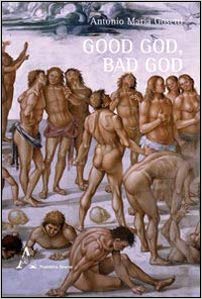
Good God, Bad God (2015)
by Antonio Gosetti
translated from the Italian by Oonagh Louise Stransky
publisher: Aracne Editions
alternate-history science-fiction novel
A story within a story, the plot is framed with a narrative of a father and son on vacation. Finally on their own together, away from home, the father breaks some vital news to his son: when Christopher Columbus reached the so-called New World, the civilization he discovered was so advanced it took over Europe, and not the other way around. Everything the son has been taught up until that point has been a fabrication.
The plot goes on to unfold in an era when technology is so far ahead that people can travel through time, an invention mainly used for medical purposes, allowing scientists to eradicate illnesses before they become deadly.
Mark, an elderly professor who has been enjoying his retirement on a remote island in Greece, is called into action by two ex-colleagues who want to steal a time machine and change the destiny of humankind: they want to travel across the centuries and destroy the Imperialists, their enemy. In fact, as a young man, Mark had been an active member of the Organization, whose goal was to break down the power of the Imperialists. Mark accepts the mission: traveling in time would allow him to feel young again and it would let him relive the glories of the past. He knows it’s a practically impossible challenge, but it draws on his romantic spirit and ideals of justice.
Rich in adventure and full of surprising twists, the author manages to mix reality and imagination, seriousness and irony in a compelling and provocative narrative crescendo.
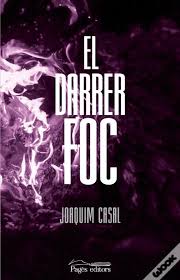
El Darrer Foc by Joaquim Casal Fàbrega
translated from the Catalan
Do we know everything about fire? After many years of studies and research, and the analysis of many fires, we think so. But this is not the case. There is another dimension to fire, another world, that our technological society does not know about. The Last Fire, which received an honourable mention in the Miquel Barceló UPC Science Fiction Award 2022, describes an enigmatic phenomenon that can appear in the flames, which the main characters investigate. Various disturbing events, first in Barcelona during research on fire protection and then in an ancient village right in the heart of the Karkas mountains in Iran, will confront them at the limits of fire and life.
Joaquim Casal (1948) is a professor emeritus at the Universitat Politècnica de Catalunya. He has published many papers and two books in the field of technology risk analysis: fires, explosions and toxic leaks. He has been a visiting professor at universities in various countries, including the Sharif University of Technology (Teheran). In the area of fiction and science fiction, he has published several stories, such as Entropia minvant (Ictineu Award 2012) and those collected in the volume L’esperit de fum i altres relats (2012). He is also the author of the novels Una recerca en dos temps, which received special mention in the UPC Science Fiction Award 2010, and Tilepadeion: I know what’s in your mind, which won the Manuel de Pedrolo Narrative Award in 2014.
